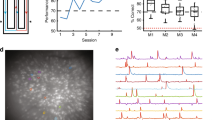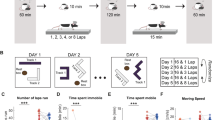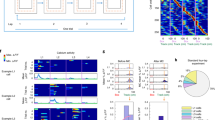Abstract
Replay of hippocampal place cell sequences has been proposed as a fundamental mechanism of learning and memory. However, the standard interpretation of replay has been challenged by reports that similar activity is observed before experience ('preplay'). By the preplay account, pre-existing temporal sequences are mapped onto new experiences without learning sequential structure. Here we employed high density recording methods to monitor hundreds of place cells simultaneously while rats explored multiple novel environments. While we observed large numbers of synchronous spiking events before experience, they were not temporally correlated with subsequent experience. Multiple measures differentiated pre-experience and postexperience events that, taken together, defined the latter but not the former as trajectory-depicting. The formation of events with these properties was prevented by administration of an NMDA-receptor antagonist during experience. These results suggest that the sequential structure of behavioral episodes is encoded during experience and reexpressed as trajectory events.
This is a preview of subscription content, access via your institution
Access options
Subscribe to this journal
Receive 12 print issues and online access
$209.00 per year
only $17.42 per issue
Buy this article
- Purchase on Springer Link
- Instant access to full article PDF
Prices may be subject to local taxes which are calculated during checkout








Similar content being viewed by others
References
Wilson, M.A. & McNaughton, B.L. Reactivation of hippocampal ensemble memories during sleep. Science 265, 676–679 (1994).
Diba, K. & Buzsáki, G. Forward and reverse hippocampal place-cell sequences during ripples. Nat. Neurosci. 10, 1241–1242 (2007).
Lee, A.K. & Wilson, M.A. Memory of sequential experience in the hippocampus during slow wave sleep. Neuron 36, 1183–1194 (2002).
Karlsson, M.P. & Frank, L.M. Awake replay of remote experiences in the hippocampus. Nat. Neurosci. 12, 913–918 (2009).
Foster, D.J. & Wilson, M.A. Reverse replay of behavioural sequences in hippocampal place cells during the awake state. Nature 440, 680–683 (2006).
Pfeiffer, B.E. & Foster, D.J. Hippocampal place-cell sequences depict future paths to remembered goals. Nature 497, 74–79 (2013).
Girardeau, G., Benchenane, K., Wiener, S.I., Buzsáki, G. & Zugaro, M.B. Selective suppression of hippocampal ripples impairs spatial memory. Nat. Neurosci. 12, 1222–1223 (2009).
Ego-Stengel, V. & Wilson, M.A. Disruption of ripple-associated hippocampal activity during rest impairs spatial learning in the rat. Hippocampus 20, 1–10 (2010).
Jadhav, S.P., Kemere, C., German, P.W. & Frank, L.M. Awake hippocampal sharp-wave ripples support spatial memory. Science 336, 1454–1458 (2012).
Olton, D.S. & Samuelson, R.J. Remembrance of places past: spatial memory in rats. J. Exp. Psychol. Anim. Behav. Process. 2, 97–116 (1976).
O'Keefe, J. & Nadel, L. The Hippocampus As A Cognitive Map (Clarendon, 1978).
Gaffan, D. Scene-specific memory for objects: a model of episodic memory impairment in monkeys with fornix transection. J. Cogn. Neurosci. 6, 305–320 (1994).
Wood, E.R., Dudchenko, P.A. & Eichenbaum, H. The global record of memory in hippocampal neuronal activity. Nature 397, 613–616 (1999).
Scoville, W.B. & Milner, B. Loss of recent memory after bilateral hippocampal lesions. J. Neurol. Neurosurg. Psychiatry 20, 11–21 (1957).
Steele, R.J. & Morris, R.G. Delay-dependent impairment of a matching-to-place task with chronic and intrahippocampal infusion of the NMDA-antagonist D-AP5. Hippocampus 9, 118–136 (1999).
Suzuki, W.A. Encoding new episodes and making them stick. Neuron 50, 19–21 (2006).
Miller, E.K. & Wilson, M.A. All my circuits: using multiple electrodes to understand functioning neural networks. Neuron 60, 483–488 (2008).
Carr, M.F., Jadhav, S.P. & Frank, L.M. Hippocampal replay in the awake state: a potential substrate for memory consolidation and retrieval. Nat. Neurosci. 14, 147–153 (2011).
Sadowski, J.H., Jones, M.W. & Mellor, J.R. Ripples make waves: binding structured activity and plasticity in hippocampal networks. Neural Plast. 2011, 960389 (2011).
Dragoi, G. & Tonegawa, S. Preplay of future place cell sequences by hippocampal cellular assemblies. Nature 469, 397–401 (2011).
Dragoi, G. & Tonegawa, S. Development of schemas revealed by prior experience and NMDA receptor knock-out. Elife 2, e01326 (2013).
Dragoi, G. & Tonegawa, S. Distinct preplay of multiple novel spatial experiences in the rat. Proc. Natl. Acad. Sci. USA 110, 9100–9105 (2013).
Dragoi, G. & Tonegawa, S. Selection of preconfigured cell assemblies for representation of novel spatial experiences. Phil. Trans. R. Soc. Lond. B 369, 20120522 (2014).
Davidson, T.J., Kloosterman, F. & Wilson, M.A. Hippocampal replay of extended experience. Neuron 63, 497–507 (2009).
Wu, X. & Foster, D.J. Hippocampal replay captures the unique topological structure of a novel environment. J. Neurosci. 34, 6459–6469 (2014).
Malenka, R.C. & Bear, M.F. LTP and LTD: an embarrassment of riches. Neuron 44, 5–21 (2004).
Morris, R.G. Synaptic plasticity and learning: selective impairment of learning rats and blockade of long-term potentiation in vivo by the N-methyl-D-aspartate receptor antagonist AP5. J. Neurosci. 9, 3040–3057 (1989).
Shapiro, M.L. & Caramanos, Z. NMDA antagonist MK-801 impairs acquisition but not performance of spatial working and reference memory. Psychobiology (Austin Tex.) 18, 231–243 (1990).
Bannerman, D.M., Good, M.A., Butcher, S.P., Ramsay, M. & Morris, R.G. Distinct components of spatial learning revealed by prior training and NMDA receptor blockade. Nature 378, 182–186 (1995).
Lowe, D.A., Neijt, H.C. & Aebischer, B. D-CPP-ene (SDZ EAA 494), a potent and competitive N-methyl-D-aspartate (NMDA) antagonist: effect on spontaneous activity and NMDA-induced depolarizations in the rat neocortical slice preparation, compared with other CPP derivatives and MK-801. Neurosci. Lett. 113, 315–321 (1990).
Kentros, C. et al. Abolition of long-term stability of new hippocampal place cell maps by NMDA receptor blockade. Science 280, 2121–2126 (1998).
Jung, M.W., Wiener, S.I. & McNaughton, B.L. Comparison of spatial firing characteristics of units in dorsal and ventral hippocampus of the rat. J. Neurosci. 14, 7347–7356 (1994).
Lee, D., Lin, B.J. & Lee, A.K. Hippocampal place fields emerge upon single-cell manipulation of excitability during behavior. Science 337, 849–853 (2012).
Feng, T., Silva, D. & Foster, D.J. Dissociation between the experience-dependent development of hippocampal theta sequences and single-trial phase precession. J. Neurosci. 35, 4890–4902 (2015).
McHugh, T.J., Blum, K.I., Tsien, J.Z., Tonegawa, S. & Wilson, M.A. Impaired hippocampal representation of space in CA1-specific NMDAR1 knockout mice. Cell 87, 1339–1349 (1996).
Ekstrom, A.D., Meltzer, J., McNaughton, B.L. & Barnes, C.A. NMDA receptor antagonism blocks experience-dependent expansion of hippocampal “place fields”. Neuron 31, 631–638 (2001).
Morris, R.G., Steele, R.J., Bell, J.E. & Martin, S.J. N-Methyl-D-aspartate receptors, learning and memory: chronic intraventricular infusion of the NMDA receptor antagonist d-AP5 interacts directly with the neural mechanisms of spatial learning. Eur. J. Neurosci. 37, 700–717 (2013).
Dupret, D., O'Neill, J., Pleydell-Bouverie, B. & Csicsvari, J. The reorganization and reactivation of hippocampal maps predict spatial memory performance. Nat. Neurosci. 13, 995–1002 (2010).
Gerrard, J.L., Burke, S.N., McNaughton, B.L. & Barnes, C.A. Sequence reactivation in the hippocampus is impaired in aged rats. J. Neurosci. 28, 7883–7890 (2008).
Quirk, M.C. & Wilson, M.A. Interaction between spike waveform classification and temporal sequence detection. J. Neurosci. Methods 94, 41–52 (1999).
Gupta, A.S., van der Meer, M.A., Touretzky, D.S. & Redish, A.D. Hippocampal replay is not a simple function of experience. Neuron 65, 695–705 (2010).
Hassabis, D., Kumaran, D., Vann, S.D. & Maguire, E.A. Patients with hippocampal amnesia cannot imagine new experiences. Proc. Natl. Acad. Sci. USA 104, 1726–1731 (2007).
Tulving, E. Episodic memory: from mind to brain. Annu. Rev. Psychol. 53, 1–25 (2002).
Acknowledgements
This work was supported by the Alfred P. Sloan Foundation (D.J.F.), the US National Institute for Mental Health (D.J.F.) and the US National Science Foundation (D.S.).
Author information
Authors and Affiliations
Contributions
D.S. and D.J.F. designed the experiment; D.S. collected the data; T.F. and D.S. developed the analyses; D.S., T.F. and D.J.F. wrote the paper. D.S. and T.F. contributed equally to this work.
Corresponding author
Ethics declarations
Competing interests
The authors declare no competing financial interests.
Integrated supplementary information
Supplementary Figure 1 Place field rate maps under saline
Example of 114 place fields from one saline session as they remap between three different tracks. The same 114 place cells are ordered by their peak firing positions on Track 1 (1st row), Track 2 (2nd row) and Track 3 (3rd row) respectively.
Supplementary Figure 2 Animals’ running speeds between different runs were not significantly different
Left, saline days, Kruskal-Wallis test: H(2)=1.87, p=0.39; right, D-CPPene days, Kruskal-Wallis test: H(2)=4.01, p=0.13. The edges of the box are the 25th (q1) and 75th (q3) percentiles of the data. The red line in the box shows the median. Red crosses mark individual outliers that are larger than q3 + 1.5*(q3 – q1) or smaller than q1 – 1.5*(q3 – q1). The black whiskers extend to the most extreme data points not considering outliers.
Supplementary Figure 3 Place field properties on saline days
Place cells remapped between different runs. Place cell firing rates, field sizes and sparsity were not significantly different between runs. Kruskal-Wallis test: H(2)=4.98, p=0.08 for place cell average firing rates; H(5)=53.4, p=2.79*10-10 for remapping index; H(2)=5.07, p=0.08 for place field size; H(2)=1.16, p=0.56 for place field sparsity. The edges of each box are the 25th (q1) and 75th (q3) percentiles of the data. The red line in each box shows the median. Red crosses mark the biggest or smallest outlier. Outliers were defined as values larger than q3 + 1.5*(q3 – q1) or smaller than q1 – 1.5*(q3 – q1). The black whiskers extend to the most extreme data points not considering outliers.
Supplementary Figure 4 Structured events prior to experience are also absent with place cells randomly downsampled or downsampled by L-ratio
(a) Distribution of spike correlations of 8310 candidate events during Sleep 1 after down-sampling to 15 cells. 15% candidate events in Sleep 1 did not produce real number correlation after down-sampling cells thus were not included in the histogram. Open bars indicate spiking events versus the original place fields templates; filled bars indicate spiking events versus 5000 shuffled templates scaled down 5000 times. Left, both place fields templates in two running directions were included (absolute correlation medians: 0.35 versus 0.36, data versus shuffle; one-tailed Wilcoxon rank sum test: p=0.75; one-tailed Kolmogorov-Smirnov test: p=0.81; Monte-Carlo P-value>0.4 with criteria of absolute correlation >0.5 or 0.6 or 0.7, see Methods). Right, only the biggest absolute spike correlation resulting from the two templates for each candidate event and shuffle were included (absolute correlation medians: 0.44 versus 0.47, data versus shuffle; one-tailed Wilcoxon rank sum test: p=1; one-tailed Kolmogorov-Smirnov test: p=1; Monte-Carlo P-value=1 with criteria of absolute correlation >0.5 or 0.6 or 0.7, see Methods). (b) Histogram (bin size=0.001) of L-ratio for 442 manually clustered, putative excitatory units in Sleep 1. Red line indicates the median value. (c) Distribution of spike correlations of 8051 candidate events during Sleep 1 after sub-sampling cells that have an L-ratio equal to or lower than the median value. 18% candidate events in Sleep 1 did not produce real number correlation after sub-sampling cells thus were not included in the histogram. Open and filled bars are as described in (a). Left, same as in (a); absolute correlation medians: 0.36 versus 0.36, data versus shuffle; one-tailed Wilcoxon rank sum test: p=0.40; one-tailed Kolmogorov-Smirnov test: p=0.60; Monte-Carlo P-value>0.1 with criteria of absolute correlation >0.5 or 0.6 or 0.7. Right, same as in (a); absolute correlation medians: 0.48 versus 0.50, data versus shuffle; one-tailed Wilcoxon rank sum test: p=1; one-tailed Kolmogorov-Smirnov test: p=1; Monte-Carlo P-value=1 with criteria of absolute correlation >0.5 or 0.6 or 0.7.
Supplementary Figure 5 Significance matrices for all runs and conditions
Running epochs are denoted as e1 (Run 1), e2 (Run 2), e3 (Run 3); sleep epochs are denoted as s1 (Sleep 1), s2 (Sleep 2), s3 (Sleep 3); saline and D-CPPene days are denoted as sal and cpp respectively. Sleep 1 is the sleep epoch before any running experience, and the significance matrices for Sleep 1 (1st column) are denoted as e1s1, e2s1 and e3s1, using place fields from Track 1, Track 2 and Track 3 respectively. Significant matrices during current running experiences are denoted as e1e1, e2e2, e3e3 for three tracks respectively (2nd column). Significant matrix of retrieved Track 1 place fields during Sleep 2 is denoted as e1s2 (3nd column). Significant matrices during Sleep 3 are denoted as e1s3, e2s3, e3s3 respectively for three tracks (4th column). Red box denotes post-experience on D-CPPene days, where red dashed box denotes the D-CPPene epoch before drug administration (Run 1).
Supplementary Figure 6 Chemical structure of d-CPPene and activity profile
The first selective NMDAR antagonists AP5((2R)-amino-5-phosphonovaleric acid; (2R)-amino-5-phosphonopentanoate) and AP-7 had to be infused via mini-pumps directly into the brain due to poor penetration of the blood brain barrier. CPP,3-(2-Carboxypiperazin-4-yl)propyl-1-phosphonic acid, was synthesized as a rigid analog of AP-7 and is a potent, selective, and competitive antagonist of NMDA-type receptors that can be administered intra-peritoneally (Lehmann et al., 1987). D-CPPene, D-4-[(2E)-3-Phosphono-2-propenyl]-2-piperazinecarboxylic acid, is an analog of CPP, as seen above. D-CPPene is the most potent, enantiomerically pure, competitive NMDA antagonist (Lowe et al., 1990).The standard form of CPP used in previous place cell studies has been a racemic mixture including both enantiomers (D- and L-) (e.g. Ekstrom et al., 2001; Kentros et al., 1998). For both CPP and CPPene the D-enantiomer is 15-20 times more potent than the L-enantiomer. D-CPPene is 4.7 times more potent than DL-CPP and 2.2 times more potent than D-CPP (Lowe et al., 1990).
Aebischer, B., Frey, P., Haerter, H.P., Herrling, P.L., Mueller, W., Olverman, H.J., and Watkins, J.C. (1989). Synthesis and NMDA Antagonistic Properties of the Enantiomers of 4-(3-Phosphonopropyl)Piperazine-2-Carboxylic Acid (Cpp) and of the Unsaturated Analog (E)-4-(3-Phosphonoprop-2-Enyl)Piperazine-2-Carboxylic Acid (Cpp-Ene). Helv Chim Acta 72, 1043-1051.
Lehmann, J., Schneider, J., McPherson, S., Murphy, D.E., Bernard, P., Tsai, C., Bennett, D.A., Pastor, G., Steel, D.J., Boehm, C., et al. (1987). CPP, a selective N-methyl-D-aspartate (NMDA)-type receptor antagonist: characterization in vitro and in vivo. J Pharmacol Exp Ther 240, 737-746.
Lowe, D.A., Neijt, H.C., and Aebischer, B. (1990). D-CPP-ene (SDZ EAA 494), a potent and competitive N-methyl-D-aspartate (NMDA) antagonist: effect on spontaneous activity and NMDA-induced depolarizations in the rat neocortical slice preparation, compared with other CPP derivatives and MK-801. Neurosci Lett 113, 315-321.
Ekstrom, A.D., Meltzer, J., McNaughton, B.L., and Barnes, C.A. (2001). NMDA receptor antagonism blocks experience-dependent expansion of hippocampal "place fields". Neuron 31, 631-638.
Kentros, C., Hargreaves, E., Hawkins, R.D., Kandel, E.R., Shapiro, M., and Muller, R.V. (1998). Abolition of long-term stability of new hippocampal place cell maps by NMDA receptor blockade. Science 280, 2121-2126.
Supplementary Figure 7 Place field properties on d-CPPene days
Place cells remapped between different runs. Place cell average firing rates, field sizes are not significantly different between runs. Place field sparsity increased after drug administration. Kruskal-Wallis test: H(2)=3.78, p=0.15 for place cell average firing rates; H(5)=50.75, p=9.73*10-10 for remapping index; H(2)=6.83, p=0.03 for place field size, however post-hoc Bonferroni correction did not identify any run experience that is significantly different to others; H(2)=155.24, p<10-10 for place field sparsity, post-hoc Bonferroni correction indicates all runs are significantly different to each other.
Supplementary Figure 8 Place field rate maps under d-CPPene
Example of 111 place fields from one saline session as they remap between three different tracks. The same 111 place cells are ordered by their peak firing positions on Track 1 (1st row), Track 2 (2nd row) and Track 3 (3rd row) respectively.
Supplementary Figure 9 Position reconstruction during run
Cumulative distribution of the construction error during run for saline (blue) and D-CPPene (red) sessions (group data). Black and dashed black lines are respectively the decoding qualities at chance level for saline and D-CPPene days. Median ± s.e.m of construction error, saline versus D-CPPene, Wilcoxon rank sum test: 4.34 ± 0.25 versus 4.86± 0.25, p=0.08 for Run 1; 10.14 ± 0.38 versus 13.23± 0.43, p<10-10 for Run 2; 10.43 ± 0.38 versus 16.94± 0.46, p<10-10 for Run 3. All the decoding are significantly better than chance (p<10-10).
Supplementary Figure 10 Run decoding and replay decoding with diffuse place fields
(a) Histograms of place field sparsity from saline days. (b) Position decoding for each Run using only the subset of place fields with sparsity value greater than 0.5. The decoding qualities of the degraded decoder (blue) are significantly better than chance (black) for all three runs (Wilcoxon rank sum test, p<10-10). (c) Top 6 correlated events expressed during saline Runs using only diffuse place fields. (d) Corresponding significance matrix for trajectory events.
Supplementary information
Supplementary Text and Figures
Supplementary Figures 1–10 and Supplementary Tables 1 and 2 (PDF 1091 kb)
Rights and permissions
About this article
Cite this article
Silva, D., Feng, T. & Foster, D. Trajectory events across hippocampal place cells require previous experience. Nat Neurosci 18, 1772–1779 (2015). https://doi.org/10.1038/nn.4151
Received:
Accepted:
Published:
Issue Date:
DOI: https://doi.org/10.1038/nn.4151
This article is cited by
-
The generative grammar of the brain: a critique of internally generated representations
Nature Reviews Neuroscience (2024)
-
Memory capacity and prioritization in female mice
Scientific Reports (2023)
-
The role of experience in prioritizing hippocampal replay
Nature Communications (2023)
-
De novo inter-regional coactivations of preconfigured local ensembles support memory
Nature Communications (2022)
-
Reactivation predicts the consolidation of unbiased long-term cognitive maps
Nature Neuroscience (2021)



